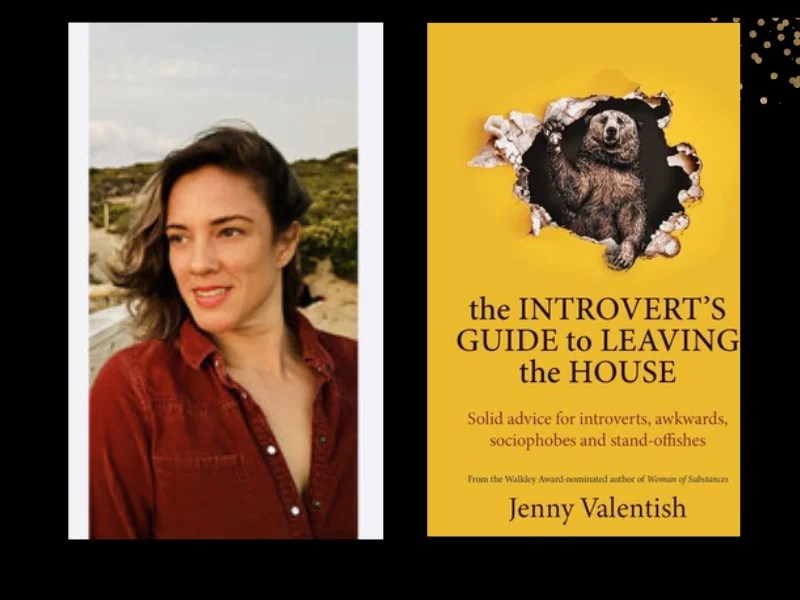Introvert’s Guide: quick links
As an introvert herself, Jenny Valentish is clear on her approach in The Introvert’s Guide to Leaving the House: if you’re happy with your current level of socialisation (no matter how minimal it is), that’s great, you don’t need advice.
After all, when you’re giving advice, there’s a fine line between imparting helpful social guidance and suggesting there’s something wrong with being introverted. For other introverts, it’s not that they need ‘curing’. Rather, ‘sometimes we can do with a few aces up our sleeves to navigate the interactions of life’.
Introvert’s Guide: structure
The Introvert’s Guide delivers 23 chapters framed by one of Valentish’s personal anecdotes, or the wisdom of someone who succeeds at some aspect of social life. The chapters culminate in a ‘go forth list’ – some actionable suggestions about things to try.
The content is quite vast in scope, discussing concepts like social battery, Dutch courage, small talk, phone anxiety and more.
The wide scope also captures a wide potential audience. Although the title refers to introverts, the subtitle also includes ‘awkwards, sociophobes and stand-offishes’. The book further discusses clinical diagnoses that can make socialisation difficult, like social anxiety, various forms of neurodivergence and sensory sensitivities and attachment patterns.
Introvert’s guide: addiction
Addiction, which can be used to compensate for social anxiety, is also discussed. The upside of this large scope is that there is likely to be something useful for everyone. The downside is that there is an overwhelming amount of advice for so many different situations that readers looking to change their outlook and behaviours will need to take a step back to figure out how they might implement it in a sustainable way.
Introvert’s Guide: lived experience
Though big in scope, Valentish’s voice of lived experience goes far in developing a relationship with the reader that feels genuinely non-judgemental. It is clear that Valentish has thought about socialisation in great depth, from many different angles.
But she still finds herself avoiding events, leaving gatherings early and being unfriendly at an airport. These things are ongoing challenges and as she reflects, ‘I don’t believe reserved folks can just paste on a huge smile and ramp up the volume’. Her admissions of imperfection impart the sense that there aren’t easy answers, but many opportunities for self-examination.
Narrative parts of the book are often memorable, especially when Valentish challenges herself to do an activity that gets her out of the house and her comfort zone. For example, Valentish describes entering into a bodybuilding contest – where she had to parade on stage in a bikini after cultivating muscle definition. She also tries ecstatic dancing and gets her partner to try cuddle gatherings as a means of hijacking the body’s ‘bonding chemicals’ to feel a greater sense of connection.
Introvert’s Guide: feeling in control
Although the book is primarily about figuring out your social life, there’s more to it than that. As Valentish herself identifies, part of the skill of social skills is allowing for a lack of control, or looking for heathy ways to feel in control. Fearing the unknown – how things will go, what others will say, what others will think – naturally increases how stressed a person may feel in a social interaction. Learning to not mind being cringe or otherwise negatively judged is a means of becoming more open and authentic.
Some of Valentish’s techniques allow people to socialise on their own terms, in ways that feel a little less intimidating than completely giving up control, things like assigning oneself a role at a social event, or taking beta blockers, can allow people to better predict how a social situation will go.
This middle way, of both letting go in some ways and strategically not fully letting go in other ways, feels more plausible than advice often given to introverts such as ‘fake it ‘til you make it’ or ‘stop caring what others think’.
Underlying this advice is an implicit message of embracing vitality. Valentish discusses activities like solo travel and indulging in ASMR videos, neither of which immediately seem to centralise socialisation. Yet both activities, if of interest to you, can promote feelings of connection – to a person on a screen, or to the wonders of the world.
The point is to embrace human experiences. This involves cultivating connections, but it doesn’t have to look like networking or party-going and it is allowed to be solo.
Read: The Revisionists review: Michelle Johnston’s third novel is a masterpiece
Valentish’s well-informed, wide-reaching advice will benefit a large audience of readers who feel like they’ll burst if they have yet another small talk conversation about the weather. It comes from a realistic, experiential, and non-judgemental perspective that isn’t invested in the reader being fundamentally different, just a bit less stressed, a little more vibrant.
The Introvert’s Guide to Leaving the House: Solid advice for introverts, awkwards, sociophobes and stand-offishes by Jenny Valentish is published by Affirm Press.






